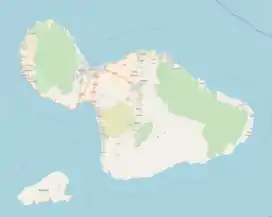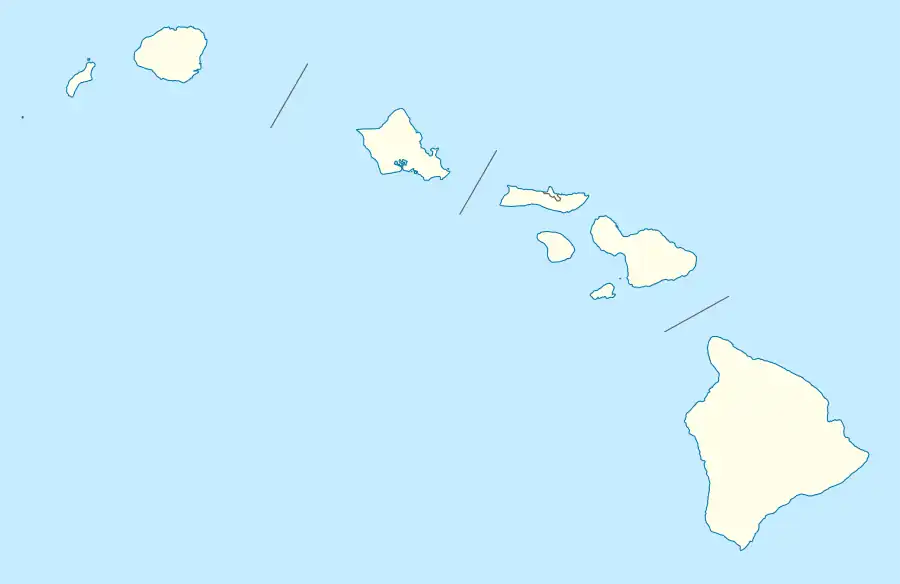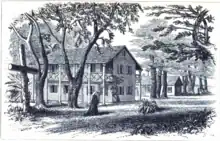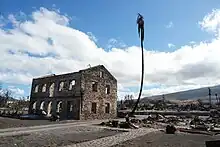United States Marine Hospital (Lahaina, Hawaii)
The U.S. Marine Hospital, also known as the U.S. Seamen's Hospital, was one of the earliest remaining buildings in Lahaina, Hawaii.[4] It is listed as a contributing property to the Lahaina Historic District.[5]
Lahaina Historic District | |
 The restored building in use in 2010 | |
   | |
| Location | Front Street, Lahaina, Hawaii |
|---|---|
| Coordinates | 20°52′46.7″N 156°40′59.4″W |
| NRHP reference No. | 66000302 |
| HRHP No. | 50-50-03-03001 |
| Significant dates | |
| Added to NRHP | October 15, 1966[1] |
| Designated NHLDCP | December 29, 1962[2] |
| Designated HRHP | October 15, 1966[3] |
The building was constructed in the 1830s as a secret hideaway for King of Hawaii Kamehameha III, and then used as a U.S. Marine Hospital during 1844–1862. Afterwards, it was used as an Anglican school and then clergy house. It was purchased in 1909 by the Bernice Pauahi Bishop Estate and used as a residence. However, the building deteriorated and was a pile of rubble by 1980. It was restored in 1982 by the Lahaina Restoration Foundation. The building's interior was again destroyed in the 2023 Hawaii wildfires.
History
Early history
The land was granted in 1831 by King of Hawaii Kamehameha III to Joaquin Armas, a cowboy and immigrant from Alta California.[4][6] The construction of the building on the property was commissioned by the King in 1833 as an inn and store for sailors, and as a remote location for the King to escape the attention of the Christian missionaries.[6] The royal involvement in the building's construction was kept secret. The building held a Chinese store in its early years.[7][8]
Hospital
The building was in use as a U.S. Marine Hospital for the benefit of civilian mariners beginning in 1844. At first, Armas leased the building to the U.S. government, but after his death, the property was auctioned off in 1855 to a John Nutter, who immediately resold it to James R. Dow, the physician in charge of the hospital at that time.[4] At the time of its opening, there were no other hospitals in Hawaii.[9] The hospital could accommodate about 60 men,[5] and had three staff.[10] During the boom years of whaling, it had well over a hundred patients each year.[9]
The hospital was closed in 1862 after a U.S. Department of State investigation found widespread graft in the administration of the hospital,[4][9] including doctors charging fees to the U.S. government for already-dead patients; and because the whaling industry had declined during the American Civil War.[6]
Private use


In 1865, the Anglican Church in Hawaii leased the property as the St. Cross School for Girls. After Dow's death, Priscilla Sellon, the Anglican Mother Superior, purchased the property in 1872. The school closed in 1877, and the Anglican Church then purchased the property from Sellon's estate in 1878. It was used for many years as a clergy house for the Anglican ministers, but gradually deteriorated.[4][9]
It was acquired by the Bernice Pauahi Bishop Estate in 1909 in exchange for another piece of property.[4] As of 1962, it was in use as a tenement residence and was considered in fair condition, although the exterior stone walls had been covered with shingles.[5][11] Later, it was used as a community meeting hall.[12] However, by 1970 it was considered at risk of disintegration.[13]
Restoration
The Lahaina Restoration Foundation acquired the building from the Bishop Estate in 1974.[6] That same year, approval was issued by the Historic Commission for construction of condominiums surrounding the Marine Hospital, which was described as a ruin. In 1976, two local residents opposed a shoreline permit needed to begin construction, in order to force an environmental impact statement to be made, since the Marine Hospital was by then listed on the National Register of Historic Places. However, construction was approved because the requirement for an environmental impact statement was only instituted in June 1975, which was after the Historic Commission approval.[14][15] Ultimately, vibrations from the condominium construction caused the Marine Hospital's walls to collapse into rubble by 1980.[12][16][17]

It was restored by architect Uwe Schulz, who personally funded the restoration in return for a 20-year lease on the property. The restoration was completed in 1982. As of 2023, the Lahaina Restoration Foundation leased out the building for business use.[6]
The building's interior was destroyed in the 2023 Hawaii wildfires, with the stone walls remaining standing.[18]
References
- "National Register Information System". National Register of Historic Places. National Park Service. March 13, 2009.
- "Lahaina Historic District". National Historic Landmark summary listing. National Park Service. Archived from the original on 2011-05-11. Retrieved 2008-06-20.
- "Historic Register Counts". Hawai'i State Historic Preservation Division. State of Hawaii. February 1, 2022. Archived from the original on September 3, 2023. Retrieved February 19, 2022.
- Gorokhoff, Cecilia J. (September 1966). "Historic American Buildings Survey: U.S. Marine Hospital, HABS No. HI-11" (PDF). Archived (PDF) from the original on 2023-09-03. Retrieved 2023-08-13.
- Apple, Russell A. (1973-12-21). "National Historic Landmark 1974 Update: Lahaina (historic district)" (pdf). National Park Service. p. 16. Archived from the original on 2023-08-31. Retrieved 2023-08-13.
 This article incorporates text from this source, which is in the public domain.
This article incorporates text from this source, which is in the public domain. - "U.S. Seamen's Hospital: Oh, if these walls could talk!". Lahaina Restoration Foundation. 2014-04-20. Archived from the original on 2023-09-03. Retrieved 2023-08-13.
- Hibbard, Don J. (2018-07-16). "Office Building (Seaman's Hospital)". Society of Architectural Historians. Archived from the original on 2023-09-03. Retrieved 2023-08-14.
- "Restoration target". Honolulu Star-Bulletin. 1976-10-08. Archived from the original on 2023-09-03. Retrieved 2023-08-28.
- Pyle, Dorothy. "The Intriguing Seamen's Hospital" (PDF). Archived (PDF) from the original on 2023-09-09. Retrieved 2023-08-13.
- Young, Peter T. (2014-09-10). "US Marine Hospital". Images of Old Hawaiʻi. Archived from the original on 2023-09-09. Retrieved 2023-08-13.
- "Lahaina: the second of two picture-features on the Maui community's restoration plan". Honolulu Star-Bulletin. 1961-09-28. Archived from the original on 2023-09-09. Retrieved 2023-08-18.
- "Public health memorial: Lahaina hospital restored". The Honolulu Advertiser. 1982-04-12. p. 8. Archived from the original on 2023-08-14. Retrieved 2023-08-13.
- Johnson, Robert (1970-03-23). "Lahaina restoration aides report gains". The Honolulu Advertiser. Archived from the original on 2023-08-18. Retrieved 2023-08-18.
- "Condominium project in Lahaina gets OK for shoreline permit". The Honolulu Advertiser. 1978-11-11. Archived from the original on 2023-08-28. Retrieved 2023-08-28.
- McCabe, Robert (1976-11-10). "Planner OK two projects on valley isle". Honolulu Star-Bulletin. p. 65. Archived from the original on 2023-08-28. Retrieved 2023-08-28.
- "Restoration of hospital is observed in Lahaina". Honolulu Star-Bulletin. 1982-04-13. Archived from the original on 2023-08-14. Retrieved 2023-08-13.
- "A bit of old Lahaina reborn". The Honolulu Advertiser. 1982-04-13. Archived from the original on 2023-08-18. Retrieved 2023-08-18.
- "Scenes From the Hawaii Fires and the Aftermath". The New York Times. 2023-08-11. Archived from the original on 2023-08-13. Retrieved 2023-08-13.
.svg.png.webp)